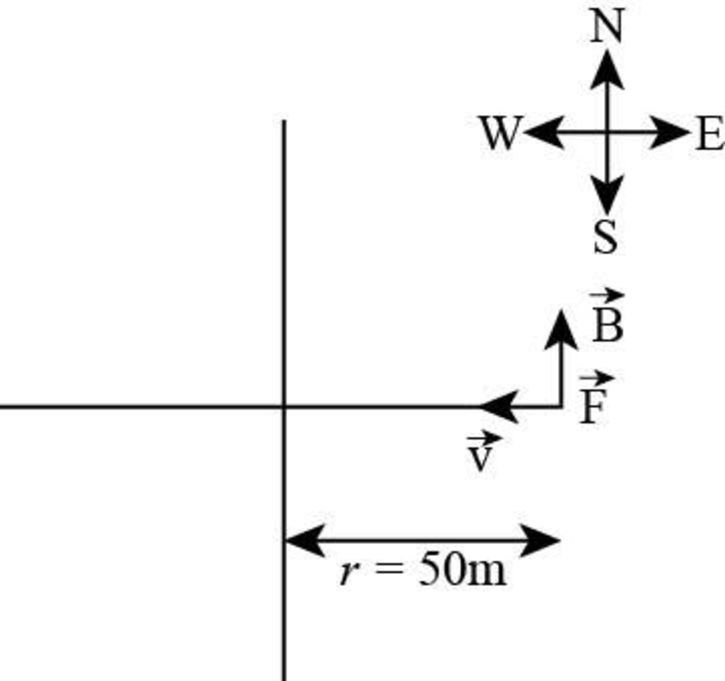
Concept explainers
(a)
The sketch showing the various vectors involved.
(a)
Explanation of Solution
The sketch showing the various vectors involved is shown in the figure below.

Figure-(1)
Here,
(b)
The vector force by lightening stoke on the electron.
(b)
Answer to Problem 16P
The vector force by lightening stoke on the electron is
Explanation of Solution
Write the expression to obtain the magnetic field along the conductor.
Here,
Write the expression to obtain the vector force on the electron.
Here,
Conclusion:
Substitute
The magnetic field in vector form.
Substitute
Therefore, the vector force by lightening stoke on the electron is
(c)
The radius of the electron’s path.
(c)
Answer to Problem 16P
The radius of the electron’s path is
Explanation of Solution
Write the expression to obtain the radius of the electron’s path.
Here,
Conclusion:
Substitute
Therefore, the radius of the electron’s path is
(d)
Weather it is good approximation to model the electron is moving in the uniform magnetic field.
(d)
Explanation of Solution
It is not good approximation to model the electron is moving in the uniform magnetic field because the magnitude of the magnetic field is not same through-out that is the magnetic field varies with the distance from the lightening stoke.
(e)
The number of revolutions the electron will complete during
(e)
Answer to Problem 16P
The number of revolutions the electron will complete during
Explanation of Solution
Write the expression to obtain the number of revolutions the electron will complete during
Here,
Write the expression to obtain the time to complete one revolution.
Here
Conclusion:
Substitute
Substitute
Therefore, the number of revolutions the electron will complete during
Want to see more full solutions like this?
Chapter 30 Solutions
Physics For Scientists And Engineers With Modern Physics, 9th Edition, The Ohio State University
- A Geiger-Mueller tube is a radiation detector that consists of a closed, hollow, metal cylinder (the cathode) of inner radius ra and a coaxial cylindrical wire (the anode) of radius г (see figure below) with a gas filling the space between the electrodes. Assume that the internal diameter of a Geiger-Mueller tube is 3.00 cm and that the wire along the axis has a diameter of 0.190 mm. The dielectric strength of the gas between the central wire and the cylinder is 1.15 × 106 V/m. Use the equation 2πrlE = 9in to calculate the maximum potential difference that can be applied between the wire and the cylinder before breakdown occurs in the gas. V Anode Cathodearrow_forward3.77 is not the correct answer!arrow_forwardA I squar frame has sides that measure 2.45m when it is at rest. What is the area of the frame when it moves parellel to one of its diagonal with a m² speed of 0.86.c as indicated in the figure? >V.arrow_forward
- An astronent travels to a distant star with a speed of 0.44C relative to Earth. From the austronaut's point of view, the star is 420 ly from Earth. On the return trip, the astronent travels speed of 0.76c relative to Earth. What is the distance covered on the return trip, as measured by the astronant? your answer in light-years. with a Give ly.arrow_forwardstar by spaceship Sixus is about 9.00 ly from Earth. To preach the star in 15.04 (ship time), how fast must you travel? C.arrow_forwardIf light-bulb A is unscrewed, how will the brightness of bulbs B and C change, if at all? How does the current drawn by from the battery change?arrow_forward
- Can someone help mearrow_forwardCan someone help me with this thank youarrow_forward(a) For a spherical capacitor with inner radius a and outer radius b, we have the following for the capacitance. ab C = k₂(b- a) 0.0695 m 0.145 m (8.99 × 10º N · m²/c²)( [0.145 m- 0.0695 m × 10-11 F = PF IIarrow_forward
 Physics for Scientists and Engineers: Foundations...PhysicsISBN:9781133939146Author:Katz, Debora M.Publisher:Cengage Learning
Physics for Scientists and Engineers: Foundations...PhysicsISBN:9781133939146Author:Katz, Debora M.Publisher:Cengage Learning Physics for Scientists and Engineers, Technology ...PhysicsISBN:9781305116399Author:Raymond A. Serway, John W. JewettPublisher:Cengage Learning
Physics for Scientists and Engineers, Technology ...PhysicsISBN:9781305116399Author:Raymond A. Serway, John W. JewettPublisher:Cengage Learning Glencoe Physics: Principles and Problems, Student...PhysicsISBN:9780078807213Author:Paul W. ZitzewitzPublisher:Glencoe/McGraw-Hill
Glencoe Physics: Principles and Problems, Student...PhysicsISBN:9780078807213Author:Paul W. ZitzewitzPublisher:Glencoe/McGraw-Hill Principles of Physics: A Calculus-Based TextPhysicsISBN:9781133104261Author:Raymond A. Serway, John W. JewettPublisher:Cengage Learning
Principles of Physics: A Calculus-Based TextPhysicsISBN:9781133104261Author:Raymond A. Serway, John W. JewettPublisher:Cengage Learning
 College PhysicsPhysicsISBN:9781305952300Author:Raymond A. Serway, Chris VuillePublisher:Cengage Learning
College PhysicsPhysicsISBN:9781305952300Author:Raymond A. Serway, Chris VuillePublisher:Cengage Learning





